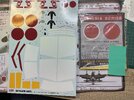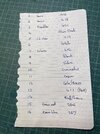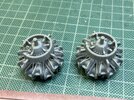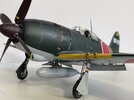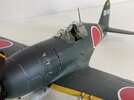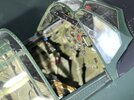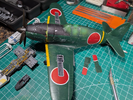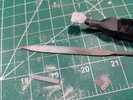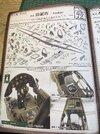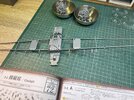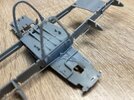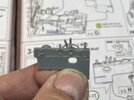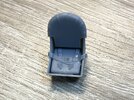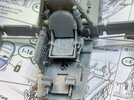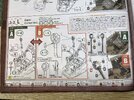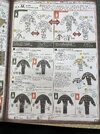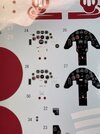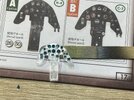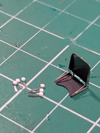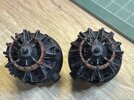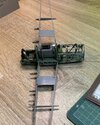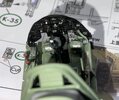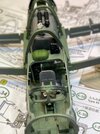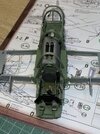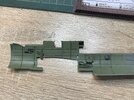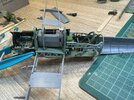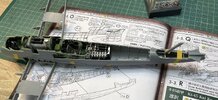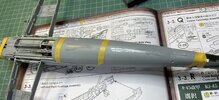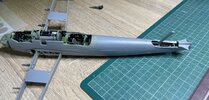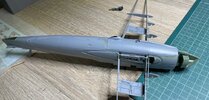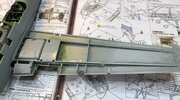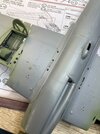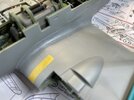BarryW
Active Member
- Joined
- Apr 17, 2025
- Messages
- 60
I see that there are several members here that are familiar with Zoukei Mura but nevertheless these kits are new to a lot of people, specially those who don't (yet) build 32 scale. Therefore I will give my 'take' on what can be a controversial brand and explain my take on these.
First of all after finishing my Hurricane build I cleaned up my build area as I always do between projects.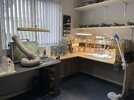
Above you can see my cleaned up build and airbrushing areas with the Ki45 out on the bench ready to start.
In the middle of the picture you can see the sprues out and ready, all with labels to help easy identification.
The box lid

Zoukei Mura produce the most detailed aircraft kits you can get in plastic without turning to etch and metal parts. They are designed to help modellers understand how the actual aircraft was built which means they provide a very different style of engineering to other manufacturers. They design their kits so you can have, if you wish, all the panels open to display all the internal details. Personally I like my kits 'buttoned up' to appreciated the clean lines of the aircraft though, where appropriate, I do like an open canopy to display a detailed cockpit.
For this build I will take my usual approach with these in building up the interior details but only painting those internal details that will be seen.
Some people accuse Zoukei Mura (ZM) of over-engineering but I disagree. I enjoy learning how the aircraft were constructed, love the detail even though I wont paint what's not seen. Also remember there are a lot of people who love to build them with all hatches open. ZM provides the options to display the model how you want.
I contend that ZM instructions are the best that you can get. Lets look through a few pages of what is a comprehensive manual. What I will say is that more than any other brand it is best to actually read and examine the instructions while following them closely during the build. Like Tamiya, if you have a problem its because of something you did.
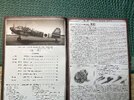

As you can see below, they provide Vallejo Model Air colour call outs. On the right you can see an exploded view of all the parts used in the first stage along with photos of how the sub-assembly will look at the end of the stage (if fully painted, of course)
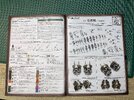
Below are the first pages of the first stage of the build. At first it looks terribly complex and crowded. But it is not if you look at it closely. Each part refers to only a few parts of the model and the various pictures show the assembly from every angle so you can see exactly how you need to fit them together with no ambiguity. Detailed diagrams are supported with photos. At the bottom of the pages all the colours needed on that page are listed. There are warnings and explanations as you go.
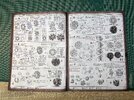
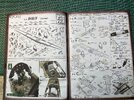
Here are the two schemes provided below for two versions of this aircraft. You have to select which of the two you are building fairly early on.


As you can see both versions offer some real painting challenges. I will be building version A,
As an aside, I got an early edition of this kit from when it was released, bought at Telford. This release includes a lot of transparent sprues to enable you to to build the model showing off internal detail with hatches closed. If you want to do this then, because the surfaces are textured, you will need to sand and polish up the areas that you want to be transparent. It would be a nice project but not one that I will take on. Its a nice thought though that I have a lot of spare kit parts if I make a big boo-boo. You can almost build a second aircraft from these transparent sprues, almost!!!!
This is what's in the box after removing the sprues that I will be using.

to be continued.....
First of all after finishing my Hurricane build I cleaned up my build area as I always do between projects.

Above you can see my cleaned up build and airbrushing areas with the Ki45 out on the bench ready to start.
In the middle of the picture you can see the sprues out and ready, all with labels to help easy identification.
The box lid

Zoukei Mura produce the most detailed aircraft kits you can get in plastic without turning to etch and metal parts. They are designed to help modellers understand how the actual aircraft was built which means they provide a very different style of engineering to other manufacturers. They design their kits so you can have, if you wish, all the panels open to display all the internal details. Personally I like my kits 'buttoned up' to appreciated the clean lines of the aircraft though, where appropriate, I do like an open canopy to display a detailed cockpit.
For this build I will take my usual approach with these in building up the interior details but only painting those internal details that will be seen.
Some people accuse Zoukei Mura (ZM) of over-engineering but I disagree. I enjoy learning how the aircraft were constructed, love the detail even though I wont paint what's not seen. Also remember there are a lot of people who love to build them with all hatches open. ZM provides the options to display the model how you want.
I contend that ZM instructions are the best that you can get. Lets look through a few pages of what is a comprehensive manual. What I will say is that more than any other brand it is best to actually read and examine the instructions while following them closely during the build. Like Tamiya, if you have a problem its because of something you did.


As you can see below, they provide Vallejo Model Air colour call outs. On the right you can see an exploded view of all the parts used in the first stage along with photos of how the sub-assembly will look at the end of the stage (if fully painted, of course)

Below are the first pages of the first stage of the build. At first it looks terribly complex and crowded. But it is not if you look at it closely. Each part refers to only a few parts of the model and the various pictures show the assembly from every angle so you can see exactly how you need to fit them together with no ambiguity. Detailed diagrams are supported with photos. At the bottom of the pages all the colours needed on that page are listed. There are warnings and explanations as you go.


Here are the two schemes provided below for two versions of this aircraft. You have to select which of the two you are building fairly early on.


As you can see both versions offer some real painting challenges. I will be building version A,
As an aside, I got an early edition of this kit from when it was released, bought at Telford. This release includes a lot of transparent sprues to enable you to to build the model showing off internal detail with hatches closed. If you want to do this then, because the surfaces are textured, you will need to sand and polish up the areas that you want to be transparent. It would be a nice project but not one that I will take on. Its a nice thought though that I have a lot of spare kit parts if I make a big boo-boo. You can almost build a second aircraft from these transparent sprues, almost!!!!
This is what's in the box after removing the sprues that I will be using.

to be continued.....

